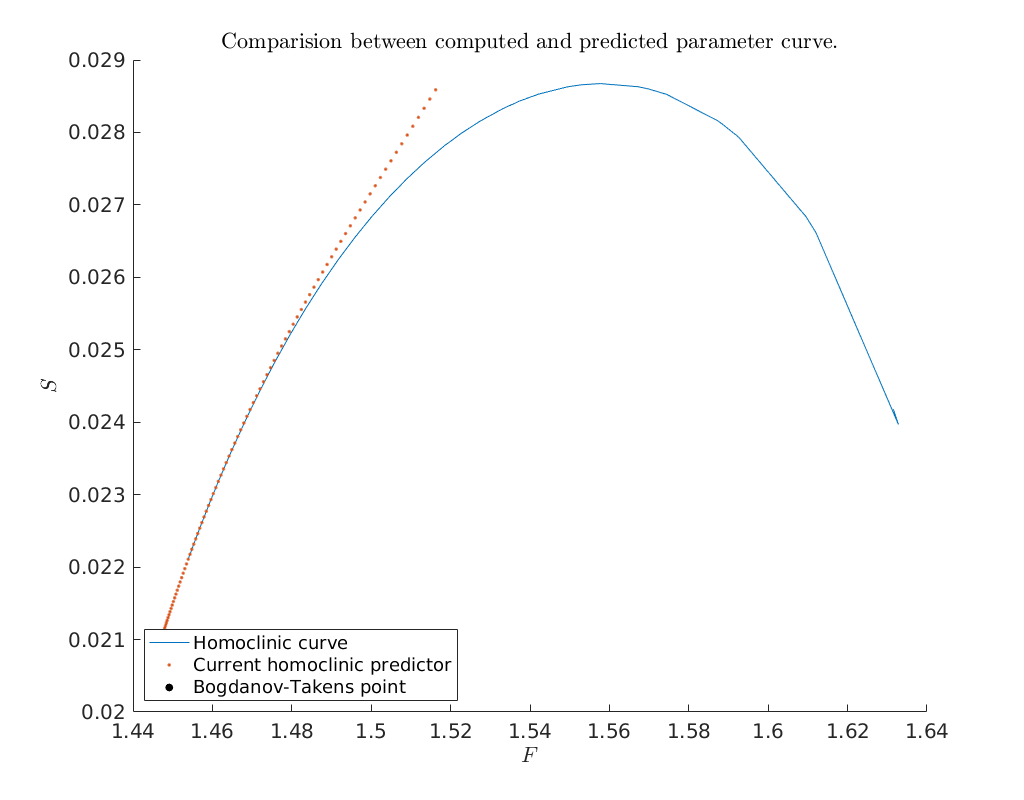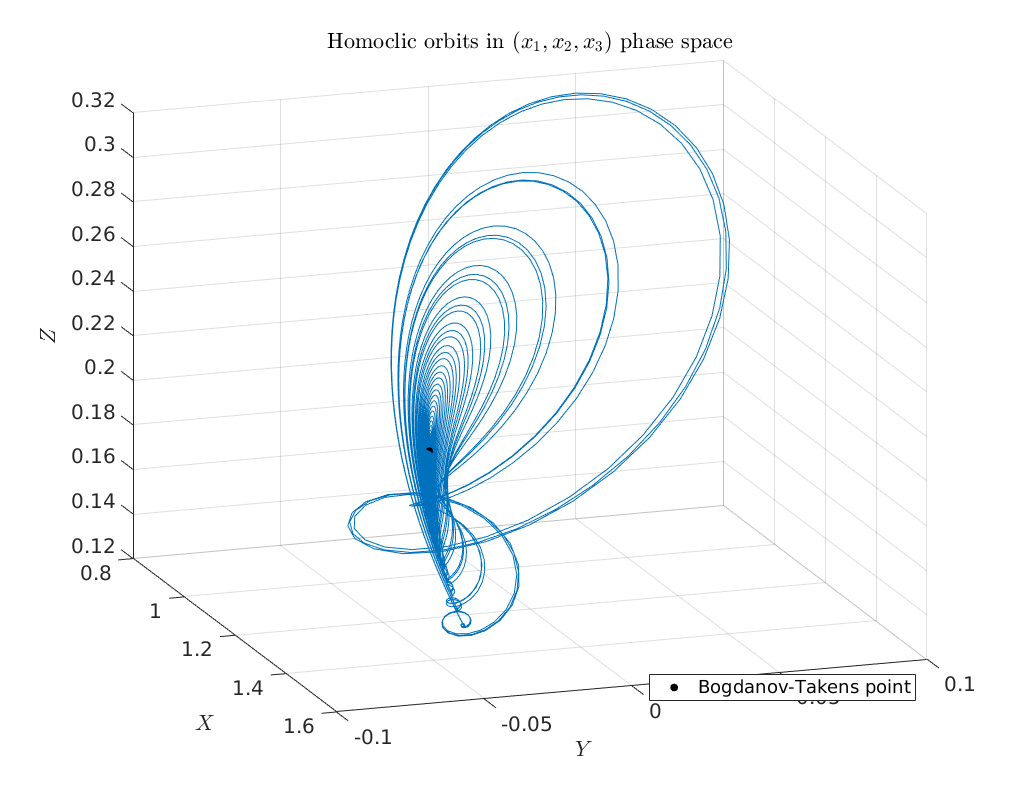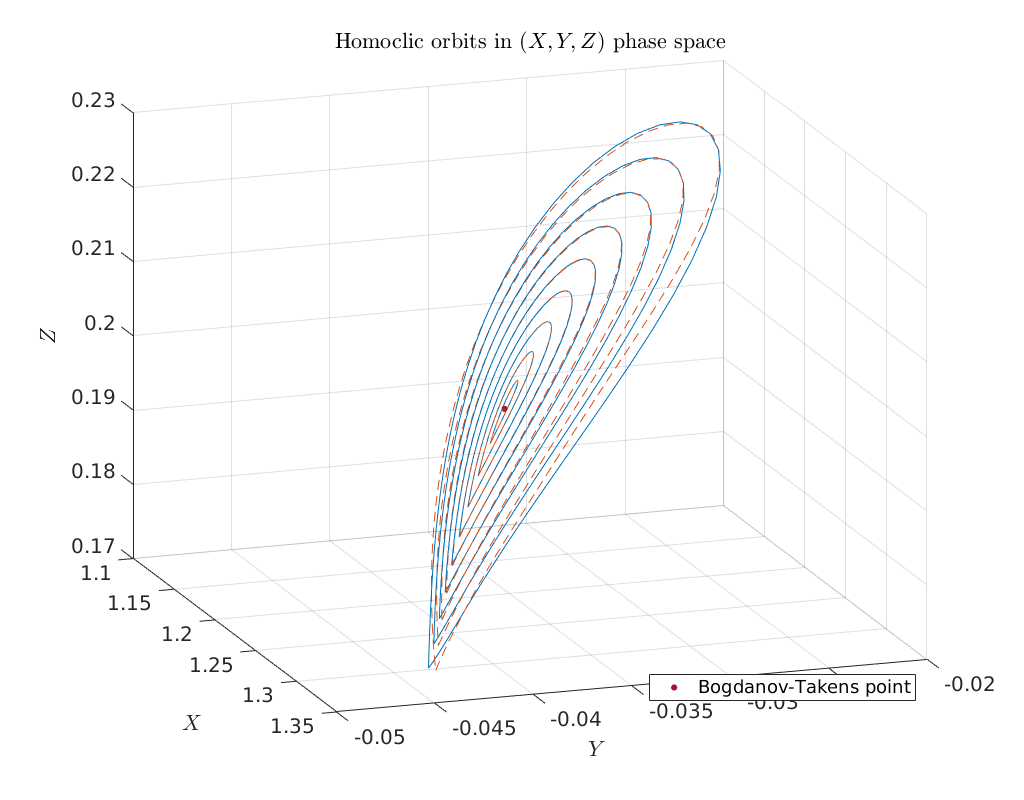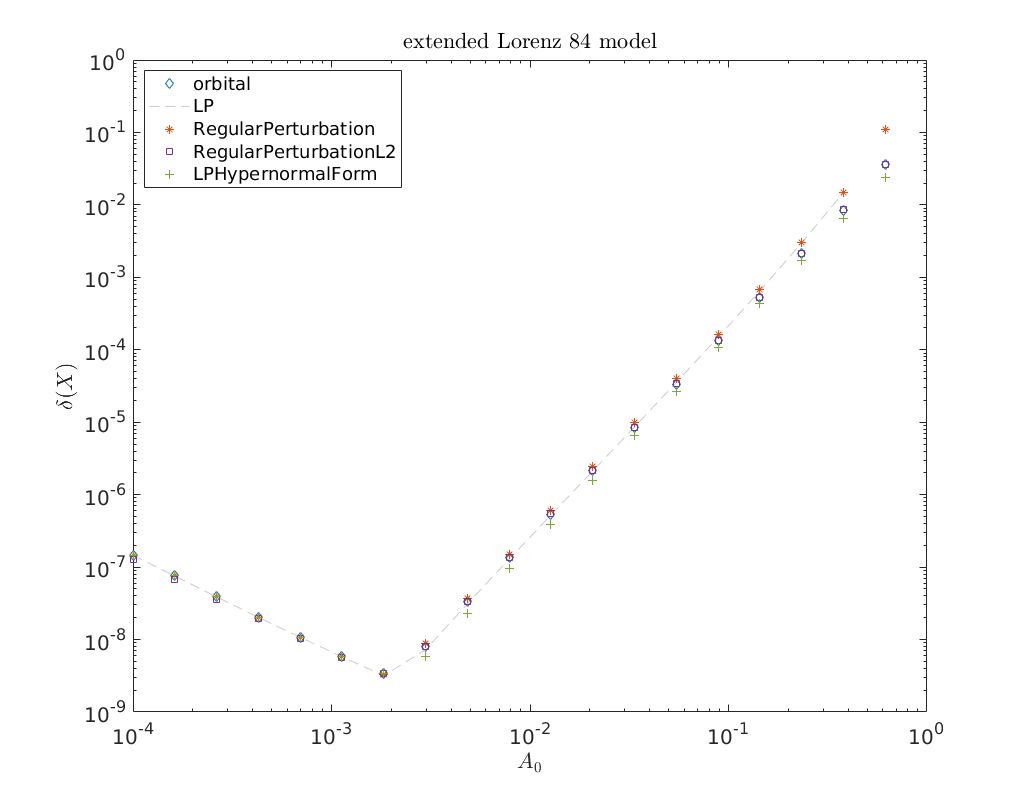The extended Lorenz-84 model¶
The extended Lorenz-84 model given by
Here \(X\) models the intensity of a baroclinic wave, \(Y\) and \(Z\) the sin and cos coefficients of the wave respectively, the variable \(U\) is added to study the influence of external parameters such as temperature. In this model all codimension two bifurcation points of equilibria are present, see [KMGS08, ShilNikovNN95, vV03]. We fix the parameters as follows \(\alpha=0.25, \beta=1, G=0.25, \delta=1.04\) and \(\xi=0.987\). The continuation parameters are \(F\) and \(S\).
Overview¶
In this demo we will
Define a numerically derive Bogdanov-Takens point.
Start continuation of the homoclinic branch emanating from the Bogdanov-Takens points in two parameters \((F,S)\) using the new homoclinic smooth orbital predictor from [Kuz21].
Compare the predicted and computed homoclinic bifurcation curve emanating from the Bogdanov-Takens point in parameters space.
Compare a range of predictors for the homoclinic solutions emanating from the Bogdanov-Takens point with the corrected homoclinic solutions curve in phase-space.
Create a convergence plot of the different homoclinic approximations derived in [Kuz21].
Load MatCont¶
Before we can start using MatCont we need to add the main directory of
MatCont, as well as various subdirectories of MatCont, to the MATLAB
search path. This is done in the code below. The variable matcont_home
should point to the main directory of MatCont.
clear all
restoredefaultpath
matcontpath = '../../';
addpath(matcontpath)
addpath([matcontpath, 'Equilibrium'])
addpath([matcontpath, 'Systems'])
addpath([matcontpath, 'Hopf'])
addpath([matcontpath, 'Homoclinic'])
addpath([matcontpath, 'LimitPoint'])
addpath([matcontpath, 'LimitCycle'])
addpath([matcontpath, 'Continuer'])
addpath([matcontpath, 'MultilinearForms'])
addpath([matcontpath, 'Utilities'])
set(groot, 'defaultTextInterpreter', 'LaTeX');
set(0,'defaultAxesFontSize',15)
Set the odefile¶
Next we set the variable odefile to the system file previously generated by
the notebook Lorenz84GenSym.ipynb.
odefile=@extendedLorenz84;
Define Bogdanov-Takens point manually¶
By numerically solving for real equilibria of (8) with double zero eigenvalues we obtain two equilibria. The first equilibrium is given by
while the second is obtained from the symmetry [ (X,Y,Z,U,F,S) \mapsto (X,Y,Z,-U,F,-S) .]
Thus we can explicitly define the Bogdanov-Takens point
X = 1.225640495986278;
Y = -0.036320793271068824;
Z = 0.19728832311233313;
U = -0.12339001198518826;
F = 1.446716701115361;
S = 0.020940169683322466;
bt1.x = [X; Y; Z; U];
bt1.par = [F; S];
To refer to the parameters throughout the script we create a cell array of
strings containing the parameter names. This is then converted into a
struct. This allows us to refer to the parameters as ind.parametername,
similar as done in DDE-BifTool.
parnames = {'F', 'S'};
cind = [parnames;num2cell(1:length(parnames))];
ind = struct(cind{:});
Continue homoclinic curve emanating from the Bogdanov-Takens point¶
To continue the homoclinic curve emanating from the Bogdanov-Takens point we
use the functions BT_Hom_set_options and init_BT_Hom to obtain an initial
approximation to the homoclinic solution (hom_x) as well as a tangent vector
to the discretized homoclinic solution (hom_v) as described in
Initial prediction of homoclinic orbit near Bogdanov-Takens point 1.
ap = [ind.F, ind.S];
BToptions = BT_Hom_set_options();
[hom_x, hom_v] = init_BT_Hom(odefile, bt1, ap, BToptions);
opt = contset;
opt.Singularities = 0;
homoclinic_br1 = cont(@homoclinic, hom_x, hom_v, opt);
Center manifold coefficients' accuracy: 1.887379e-15
BT normal form coefficients:
a=2.144234e-01, b=6.065146e-01
The initial perturbation parameter epsilon: 1.000000e-01
The initial amplitude: 0.0349736
The initial half-return time T: 116.985
The initial distance eps0: 1.96422e-05
The initial distance eps1: 6.35711e-05
first point found
tangent vector to first point found
Current step size too small (point 43)
elapsed time = 2.5 secs
npoints curve = 43
Compare predicted with computed parameters¶
Now that we have obtained a curve of homoclinic orbits (homoclinic_br) we
compare the computed curve in parameter space with the predicted curve we
construct below. To do so, we use the function BT_nmfm_orbital to obtain the
smooth orbital normal form coefficients, i.e. \(a\) and \(b\), and the coefficients
of the transformation \(K\) between the parameters of the system and the parameters
of the smooth orbital normal form on the center manifold, see
[Kuz21].
%plot --width 1024 --height 800
hold on
global homds
% plot computed parameter curve
plot(homoclinic_br1(homds.PeriodIdx+1,:), ...
homoclinic_br1(homds.PeriodIdx+2,:));
% Bogdanov-Takens parameter-dependent normal form coefficients
bt1 = BT_nmfm_orbital(odefile, bt1, ap, BToptions);
a = bt1.nmfm.a;
b = bt1.nmfm.b;
K10 = bt1.nmfm.K10;
K01 = bt1.nmfm.K01;
K02 = bt1.nmfm.K02;
K11 = bt1.nmfm.K11;
K03 = bt1.nmfm.K03;
% construct predictor as in the paper
eps = linspace(0, 0.3);
beta1 = -4*a^3/b^4*eps.^4;
tau0 = 10/7;
tau2 = 288/2401;
beta2 = a/b*(tau0 + tau2*eps.^2).*eps.^2;
alpha = K10.*beta1 + K01.*beta2 + 1/2*K02.*beta2.^2 ...
+ K11.*beta1.*beta2 + 1/6*K03.*beta2.^3;
alpha = bt1.par(ap) + alpha;
% plot currect predictor
plot(alpha(1,:), alpha(2,:), '.', 'LineWidth', 8)
% plot Bogdanov-Takens point
plot(bt1.par(ind.F), bt1.par(ind.S), '.k', 'MarkerSize', 20)
% set axis labels and legend
xlabel('$F$')
ylabel('$S$')
legend({'Homoclinic curve', 'Current homoclinic predictor', ...
'Bogdanov-Takens point'}, 'Location', 'SouthWest')
title('Comparision between computed and predicted parameter curve.')
Center manifold coefficients' accuracy: 1.887379e-15

Plot of continued homoclinic solutions in \((X,Y,Z)\) phase-space¶
To obtain an impression of the homoclinic solutions we plot the computed homoclinic orbits in \((X,Y,Z)\) phase-space.
hold on
plot3(homoclinic_br1(homds.coords(1:homds.nphase:end), 1:end), ...
homoclinic_br1(homds.coords(2:homds.nphase:end), 1:end), ...
homoclinic_br1(homds.coords(3:homds.nphase:end), 1:end), ...
'Color', [0 0.4470 0.7410], 'HandleVisibility', 'Off')
xlabel('$X$')
ylabel('$Y$')
zlabel('$Z$')
plot3(bt1.x(1), bt1.x(2), bt1.x(3), '.k' ,'MarkerSize', 20)
legend('Bogdanov-Takens point', 'Location', 'SouthEast')
title('Homoclic orbits in $(x_1,x_2,x_3)$ phase space')
grid on
view([71, 20]);

Predictors of orbits for various epsilons¶
Below we compute for a range of amplitudes the predicted and corrected homoclinic solutions and compare them in phase space. As seen from the plot above the homoclinic solutions start to deform rather quickly. Therefore, we cannot expect the approximation to be accurate for relative large amplitude values. Still, for an amplitude of \(0.3\) the approximation is nearby the corrected homoclinic solutions.
options = BT_Hom_set_options();
options.messages = false;
options.correct = false;
options.TTolerance = 1.0e-05;
amplitudes = linspace(1.0e-03, 0.3, 10);
XPredicted = zeros(658,length(amplitudes));
XCorrected = zeros(658,length(amplitudes));
for j=1:length(amplitudes)
options.amplitude = amplitudes(j);
[x_pred, v0] = init_BT_Hom(odefile, bt1, ap, options);
XPredicted(:,j) = x_pred;
try
XCorrected(:,j) = newtcorr(x_pred, v0);
catch
warning('Didn''t convergence to homoclinic solution')
end
end
hold on
cm = lines;
plot3(XPredicted(homds.coords(1:homds.nphase:end),1:10), ...
XPredicted(homds.coords(2:homds.nphase:end),1:10), ...
XPredicted(homds.coords(3:homds.nphase:end),1:10), ...
'color', cm(1,:), 'HandleVisibility', 'Off')
plot3(XCorrected(homds.coords(1:homds.nphase:end),1:10), ...
XCorrected(homds.coords(2:homds.nphase:end),1:10), ...
XCorrected(homds.coords(3:homds.nphase:end),1:10), ...
'--', 'color', cm(2,:), 'HandleVisibility', 'Off')
plot3(bt1.x(1), bt1.x(2), bt1.x(3), '.', 'MarkerSize', 16)
legend('Bogdanov-Takens point', 'Location', 'SouthEast')
title('Homoclic orbits in $(X,Y,Z)$ phase space')
xlabel('$X$')
ylabel('$Y$')
zlabel('$Z$')
grid on
view([71, 20]);

Convergence plot¶
We finish this notebook with a log-log convergence plot comparing the different
third order homoclinic approximation methods derived in [Kuz21]
to approximate the homoclinic solutions near the first Bogdanov-Takens point.
On the abscissa is the amplitude \(A_0\) and on the ordinate the relative error
\(\delta\) between the constructed solution (x_pred) to the defining for the
homoclinic orbit and the Newton corrected solution (x_corrected).
BToptions = BT_Hom_set_options();
BToptions.TTolerance = 1e-05;
BToptions.messages = false;
BToptions.correct = false;
amplitudes = logspace(-4, 0, 20);
methodList = {'orbital', 'LP', 'RegularPerturbation', ...
'RegularPerturbationL2', 'LPHypernormalForm'};
relativeErrors = {};
for i=1:length(methodList)
BToptions.method = methodList{i};
relativeErrors{i} = zeros(size(amplitudes));
for j=1:length(amplitudes)
BToptions.amplitude = amplitudes(j);
[x_pred, v0] = init_BT_Hom(odefile, bt1, ap, BToptions);
try
x_corrected = newtcorr(x_pred, v0);
relativeErrors{i}(j) = norm(x_corrected-x_pred)/norm(x_corrected);
catch
warning('Did not converge.')
continue
end
end
end
cm = lines();
loglog(amplitudes, relativeErrors{1}(:), 'd', ...
amplitudes, relativeErrors{2}(:), '--', ...
amplitudes, relativeErrors{3}(:), '*', ...
amplitudes, relativeErrors{4}(:), 's', ...
amplitudes, relativeErrors{5}(:), '+')
legend(methodList, 'Location', 'NorthWest')
title('extended Lorenz 84 model')
xlabel('$A_0$')
ylabel('$\delta(X)$')
ax = gca;
ax.ColorOrder = [cm(1,:); [0.8 0.8 0.8]; cm(2,:); cm(4,:); cm(5,:)];
Warning: Did not converge.
Warning: Did not converge.
Warning: Did not converge.
Warning: Did not converge.
Warning: Did not converge.
Warning: Did not converge.

